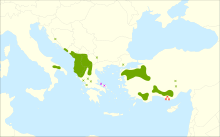Quercus trojana
Quercus trojana, the Macedonian oak is an oak in the 'turkey oak section' (Quercus sect. Cerris).
| Macedonian oak | |
|---|---|
| Scientific classification | |
| Kingdom: | Plantae |
| Clade: | Tracheophytes |
| Clade: | Angiosperms |
| Clade: | Eudicots |
| Clade: | Rosids |
| Order: | Fagales |
| Family: | Fagaceae |
| Genus: | Quercus |
| Subgenus: | Quercus subg. Quercus |
| Section: | Quercus sect. Cerris |
| Species: | Q. trojana |
| Binomial name | |
| Quercus trojana Webb[1] | |
 | |
| Distribution map | |
| Synonyms[2] | |
|
List
| |
It is native to southeast Europe and southwest Asia, from southern Italy east across the southern Balkans to western Turkey, growing at low to moderate altitudes (up to 1550 m in the south of the range in southwestern Turkey), in dry areas.[3][4][5]
Description
Quercus trojana is a small to medium-sized tree reaching 10–20 m tall, late deciduous to semi-evergreen, with grey-green leaves 3–7 cm long and 1.5–4 cm broad with a coarsely serrated margin with sharply pointed teeth. The acorns are 2–4 cm long when mature about 18 months after pollination, and largely enclosed in the scaly acorn cup.[6]
Fossil record
Fossils of Quercus trojana have been described from the fossil flora of Kızılcahamam district in Turkey, which is of early Pliocene age.[7]
References
- "Quercus trojana Webb". Tropicos. Missouri Botanical Garden.
- "Quercus trojana Webb". World Checklist of Selected Plant Families (WCSP). Royal Botanic Gardens, Kew – via The Plant List.
- Christensen, Knud Ib. 1997. Flora Hellenica 1: 45
- Altervista Flora Italiana, Quercus trojana Webb
- Jerzy Zieliński, Ana Petrova and Dominik Tomaszewski 2006. Quercus trojana subsp. yaltirikii (Fagaceae), a New Subspecies from Southern Turkey. Willdenowia 36:845-849
- Webb, Philip Barker 1839.
- Kasaplıgil, B.-(1975): Pliocene Flora of Güvem village near Ankara, Turkey, Abstracts of the Papers Presented at the XII International Botanical Congress, Akademika Nauk SSSR, 1: 115, Leningrad
External links
- Quercus trojana - information, genetic conservation units and related resources. European Forest Genetic Resources Programme (EUFORGEN)